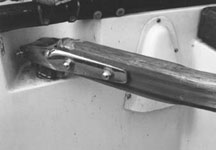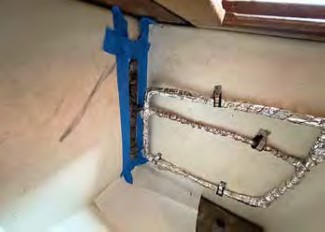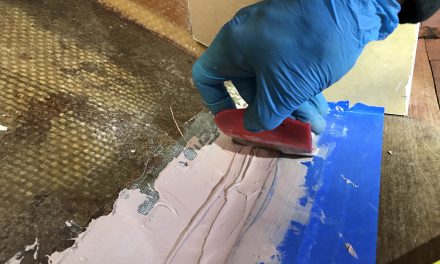Bolted boltrope? Try this handy harpoon to retrieve it.
Issue 135: Nov/Dec 2020

Drew fashioned a harpoon from a fishhook and a coat hanger. Once he retrieved the boltrope and put it in place, he sewed the sail luff shut, left. The recovered boltrope in hand shows the well-buried fishhook harpoon Drew used to retrieve it, right.
Many good old boats (and newer boats with laminate sails) feature mainsails that attach to the mast via a boltrope in the luff that slides into a groove in the mast. Still more common are grooved headsail systems in which the headsail luff slides into a groove on a foil. Though Dacron luff tape is commonly used to mitigate the inherent chafe of these systems, the tape doesn’t eliminate chafe. And when chafe finds the stitching that lies beneath, the result isn’t good.
About six months after buying my first boat, a beach cat, I hoisted the mainsail, yanked on the downhaul, and snapped the stitching that secured the boltrope to the tack. I didn’t notice it at the time, but within 30 minutes the rope had retreated 2 feet up the luff, allowing that portion of the sail to pull out of the groove. The sail was a baggy old dog, so I gladly replaced it with a better used sail.
Thirty-two years later, the same thing happened, this time on a good laminate main for my Corsair F-24. Not only was the now-empty luff pulling out of the bottom 2 feet of the mast groove, the boltrope was bunching up toward the top of the sail, herniating out of worn spots in the luff tape. I wrangled the sail back down and then wondered how I could possibly grab the lower end of the boltrope and pull it back down.
The way I saw it, fishhooks snag on everything, and if I could plant one in the tail of the boltrope, I could pull it back down. I fashioned a harpoon from a straightened 1/0 long-shank fishhook that I soldered to a straightened coat hanger. (Fishhooks made of wire are more easily straightened than forged hooks, and zinc-plated hooks solder more easily than stainless.)
I sanded and prepped both, overlapping the fishhook and the coat hanger by about an inch to provide a good bond area. I first doubled the end of the coat hanger back on itself, so that the soldered joint would be more prominent, allowing me to track the orientation of the barb inside the luff pocket by feel.
I could have laid the sail on the ground, but I instead hoisted it (on a windless day) outside the luff groove. This was a simple way to get the luff very straight. It was surprisingly easy to gently feed the hook several feet inside the luff without it snagging. I very quickly caught the end of the boltrope, but not deeply enough, and only a slight rotation on reversal eased it back out.
On my next attempt, when the hook reached the tail of the rope, I carefully positioned it in the center, pinched the rope lightly to hold it still, and gave the harpoon a deep thrust, burying the barb more than an inch into the rope. Thus buried, I knew the barb was isolated from the sailcloth and that it was safe to pull down without snagging.
I pulled gently. When I felt resistance, I stopped, pinched the rope to the luff tape with one hand, and milked the cover upwards with the other. I did this a few times, gaining a few inches at a time. Patience was key.
In 10 minutes, I had the boltrope in my hand. I removed the harpoon, allowed the rope to retract into its proper position, and secured it with eight through-stitches of doubled #4 whipping twine (I used a sailmaker’s palm and pliers). Because this had been a wear point, I folded a bit of tape over to make a taper.
I saved myself a trip to the sailmaker, and I look forward to a few more years of use from this sail.
Good Old Boat Technical Editor Drew Frye draws on his training as a chemical engineer and pastimes of climbing and sailing to solve boat problems. He cruises Chesapeake Bay and the mid- Atlantic coast in his Corsair F-24 trimaran, Fast and Furry-ous, using its shoal draft to venture into less-explored waters. He is most recently author of Rigging Modern Anchors (2018, Seaworthy Publications).
Thank you to Sailrite Enterprises, Inc., for providing free access to back issues of Good Old Boat through intellectual property rights. Sailrite.com





